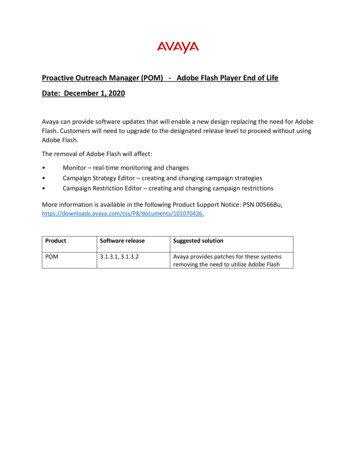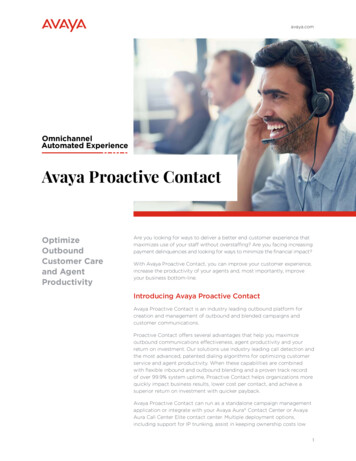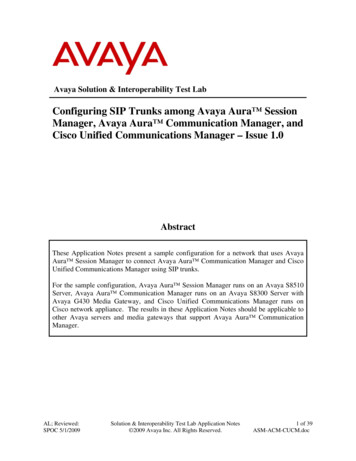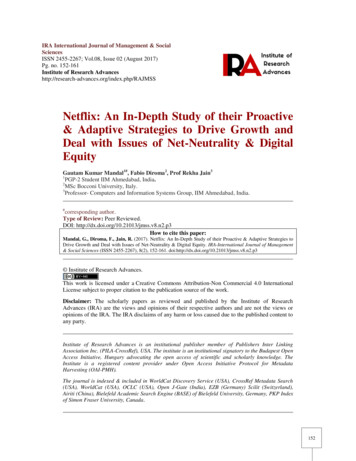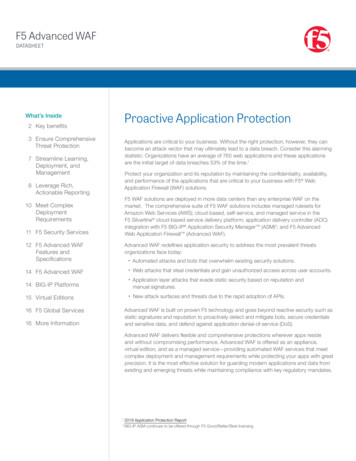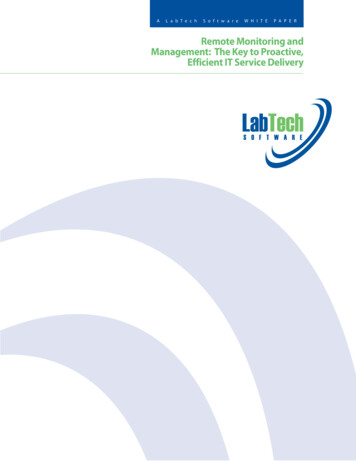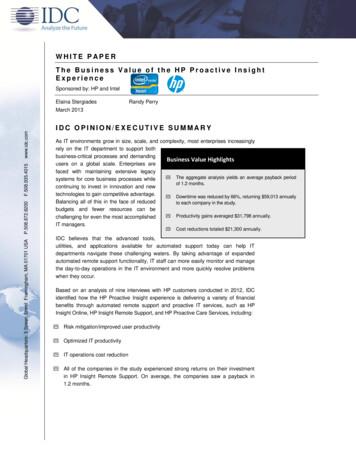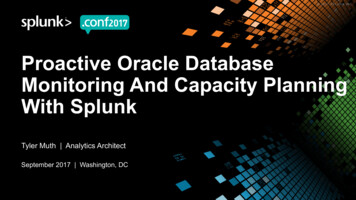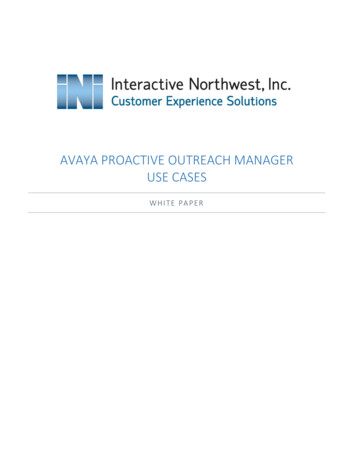
Transcription
AVAYA PROACTIVE OUTREACH MANAGERUSE CASESW HI T E PA P E R
AVAYA POM USE CASESINTRODUCTIONOne of the best ways for an enterprise-size organization to increase the efficiency of its customer interactionsand its customer experience scores is the use of proactive outreach, or outbound. Although there are regulatoryrequirements that need to be observed when an organization contacts its customers or prospective customers,proactive outreach technology provides compelling value. The Avaya Proactive Outreach Manager (POM)platform combines its full-featured outbound campaign management and outdialing engine with the powerfulAvaya Aura Experience Portal self-service platform. With the ability to use voice channels, SMS, and email, thePOM platform affords an exceptional number of solutions providing value for almost every enterprise.USE CASE GROUPSThe following categories divide proactive outreach solutions into some useful groups. While this certainly isn’t anexhaustive list of the useful groups of solutions or use cases, this paper demonstrates several concrete examplesto stimulate thinking about how each type of proactive outreach could be applied in an organizational context.Use Case Groups Covered Include: Automated NotificationOutbound Self ServiceAgent-based Outbound CampaignsIntegrated Automated/Agent Campaigns
AUTOMATED NOTIFICATIONAutomated notification is the prototypical use forproactive outreach – appointment reminders, alerts,broadcast messaging, etc.Examples: An airline gives a customer the option to receivealerts concerning his upcoming flight.This is a good case where the end user can be given achoice of receiving voice, SMS, or email notifications. A cable company contacts a customer to remind herof an upcoming service appointment date, time, andlocation.The simple outbound notification may be augmented with the ability to have the customer indicate whethersomeone will be home (“confirm”) or the appointment needs to be cancelled (“cancel”). This can be taken a stepfurther by offering an option to be transferred to an agent who can reschedule the appointment. The cable company notification is integrated with its backend scheduling system so it calls the customer toalert her that the technician is on the way, and delivers the expected arrival time.If the customer does not answer or answers that the appointment cannot be kept, the field dispatch is re-routedto another service location to avoid the cost of an ineffective truck roll. A medical practice calls its clients and uses a secure notification process to deliver sensitive information suchas medical test results.Some notifications contain sensitive information that may be protected by law, such as medical informationprotected by HIPAA or financial information that would cause harm to the organization and/or client if it reachedan unintended recipient. As POM uses self-service VoiceXML applications to interact with the called party, it ispossible to securely verify a recipient by something as simple as validating the last four digits of the social securitynumber, or as advanced as voice biometrics.
OUTBOUND SELF SERVICEAlthough the common expectation is that voice selfservice is only offered on inbound calls, there arenumerous examples where outbound self-service makeseven more sense. The application that interacts with thecalled party uses the same VoiceXML and backend dataintegration of inbound applications, making outboundself-service equally as capable.Examples: Rather than relying on callers to remain on the linefor post-call customer experience surveys or toprevent agents from disconnecting dissatisfiedcallers, post-call surveys can be delivered byoutbound campaigns.It is common to think of surveys only in the context of inbound contact center interactions, but the concept canbe extended to customer satisfaction surveys for any form of service – car repair, major appliance purchase,utility company service call, etc. An alumni association needs to verify and correct alumni data records so it uses a voice-enabled datacollection form application that can both play back information for verification and collect missinginformation.This may be an extension of the “simple survey” that asks yes/no or simple multiple choice questions to thecollection of more complex data. Numeric data can be easily collected with DTMF. With the use of automatedspeech recognition, alphanumeric data or sets of well-defined verbal categories (“directed dialog”) can becollected. Free form voice responses can also be recorded for later transcription. A collections agency uses a pay-by-phone application to target low value, “soft” collections that wouldotherwise not be cost effective for agent time.A pay-by-phone module can be a very valuable component of inbound self-service because it can be easilysecured for PCI compliance and it eliminates the exposure of sensitive card data to agents. In this outbound case,the called party is notified of a late payment and given the option to pay by previously stored card or bycollecting a credit or debit card for payment, without speak with an agent.Although this example applies the pay-by-phone capability to a collections scenario, it can also be useful in othernotification scenarios where the collection of payment information is needed to complete the interaction withthe called party.
AGENT-BASED OUTBOUND CAMPAIGNSThe Avaya POM platform supports outbound campaignsusing preview, progressive, and predictive dialingmethods. With preview dialing, the next call record isdelivered to the agent before the platform dials thenumber. This gives the agent time to study the currentrecord’s information.The platform allows the agent to have full control ofwhen dialing starts, or the campaign can put limits on theagent’s preparation time. Although preview dialingautomates the dialing process, it does not makemaximum use of agents. The agent in preview modemust still listen to call progress, encounter busy and ringno-answer conditions, and may encounter answeringdevices. The platform can detect answering devices anddeliver the campaign specific pre-recorded message,thereby relieving agents from leaving messages on numerous calls.Progressive and predictive dialing involve the platform placing calls before an agent is assigned. The platformalgorithms ensure, based on prior dialing history or on configuration parameters in the campaign, that an agent ishighly likely to be available if a call is answered by a person. These dialing methods can make very efficient use ofa team of agents to place a large number of calls. As the team size increases, predictive calling can be extremelyefficient.Examples: After a large software company customer schedules a service call online, the company’s technical supportteam connects with her using POM in preview dialing mode. Before the call is dialed, the technician reviewsthe customer-provided trouble information to expedite problem resolution and increase customer satisfaction. A debt collection agency uses the POM platform in predictive dialing mode to work through its collection lists.Calling uses a follow-the-sun model with the campaign starting in the Eastern Time zone and workingprogressively throughout the day to the Pacific Time zone.Many contact centers have both inbound and outbound functions where agents are assigned to teams dedicatedto one function. By cross training some staff as both inbound and outbound agents, it is possible to use“blending” to more effectively manage the load of both inbound and outbound calls. This is especially efficientwhen inbound call volumes fall.POM supports the standard Avaya approach to agent blending. Agents on the Avaya contact center platform(usually Avaya CM Elite) can be assigned both an inbound and an outbound skill. When POM starts a campaign, itacquires all of the agents with the outbound skill required by the particular campaign. POM uses a connector tothe Avaya CMS to monitor occupancy of the inbound queue(s). When blending is enabled, if the occupancy of theinbound queue reaches a threshold, POM releases the dual skilled agents back to the CM inbound queue. Thisreduces the number of agents that POM has available for the outbound campaign, effectively throttling its outcalling. Once the occupancy of the inbound queue falls below a lower threshold, the dual skilled agents are reacquired to complete the POM campaign.
INTEGRATED AUTOMATED AND AGENT CAMPAIGNSThe simplest automated/agent integration is proactivenotification that allows a called party to elect to speakwith an agent. Integration can ensure the outboundcampaign doesn’t send so many called parties to theinbound queue that unacceptable queuing delays occur. Aconnector between the POM platform and the Avaya CMSaccomplishes this. POM monitors the inbound transferqueue(s) and the rate of automated outbound calling, andthrottles if the inbound queue fills beyond a configuredlevel.Another integration involves the use of both agent-basedand automated either as separate campaigns or differentparts of a single campaign. The following examplesdemonstrate some of the power of using both automatedand agent campaigns in the same platform.Examples: A marketer of home beauty products uses POM with predictive dialing to connect its agents with prospectivecustomers. Once an order is taken, automated notification campaigns inform the customer when her orderhas shipped, and the expected arrival date. Subsequent automated campaigns remind her when it’s time toreorder. Customers who decline to accept are transferred to consultant agents who try to close the salepersonally.This is an example of agent-based campaigns for an activity that requires skilled agents—telesales—augmentedwith automated campaigns for efficient customer handling, customer notifications, and customer retention. A health consultancy has established programs for smoking cessation. A client is enrolled in the program andmeets periodically with a trained counselor via telephone. Automated campaigns are used to contact theclient in order to monitor compliance with the program and track progress. A client with immediate questionscan be transferred to a member of the counseling team. A personal counselor regularly contacts the client forone-on-one follow-up using a POM preview dialing campaign. Frequency of the automated and agent-basedcontact changes as the program progresses.This is an example of using automated campaigns to collect information that inform subsequent agent-basedcampaigns. By mixing both automated and agent-based contact in the outbound campaigns, the healthconsultancy gains maximum efficient use of its counseling staff. A medical device manufacturer collects client usage data via remote telemetry and provides clients withcompliance counseling. A preview dialing campaign is used to facilitate the counselors’ outreach. To increaseefficiency and allow counselors to handle more clients, an automated campaign contacts clients who are incompliance, and provides them with the summary report, praise and encouragement.In this scenario, an inefficient task requiring a larger counseling staff benefits from POM’s ability to automate thedialing. The backend system can identify clients who require personal calls from those who only need theautomated call, only calling those who need the personal touch to instruct and motivate. Both forms of outreachcan be combined in a single campaign using POM’s ability to segregate the preview calls from the automated callsin the outbound strategy.
SUMMARYThe Avaya Proactive Outreach Manager (POM) platform leverages the power of the Avaya Aura Experience Portal (AAEP)platform to create an innovative outbound engine. By harnessing the full power of the AAEP platform, automated voicecampaigns can deliver sophisticated interactions with the called parties. Voice applications have access to speech technology(automatic speech recognition, text-to-speech translation, and even voice biometrics) as well as access to backend datasources that the application can query as well as update based on the interaction with the caller.In addition to the power of a general purpose self-service platform for the voice channel, the AAEP supports bidirectionalSMS and email channels. Although there may be less costly and/or easier-to-use single-purpose platforms for SMS or emailnotification delivery, the ability to support all three channels—including combinations of these channels—sets the AvayaPOM platform apart. Adding the ability to support preview, progressive, and predictive agent-based campaigns to theautomated campaigns makes the platform an incredibly rich tool to build almost any solution requiring proactive outreach.Enterprises that recognize the opportunities they have to meet their customers’ needs by judiciously combining inboundservice (agents, telephone voice self-service, inbound SMS and email, inbound chat, and web) with proactive outreach willestablish a level of service that differentiates them from their competitors. If these contact points are carefully orchestratedto provide a unified brand experience and data is integrated between these touch points, customer experience andcustomer promoter scores can be taken to new levels.This whitepaper gives examples of how POM can be used to provide valuable real world solutions. We hope they willstimulate thinking around the ways similar solutions can be applied to other business contexts.Avaya Proactive Outreach Manager (POM) Use CasesCopyright 2018 Interactive Northwest, Inc. All Rights ReservedAbout Interactive Northwest, Inc. (INI)Since 1992, INI has been a leader in developing IVR and telephony communication solutions, and was one of the first companies withcombined expertise in host connectivity and telephony networks. INI’s software products and services follow a complete implementationlife cycle—from solution design and project management to interface development and test, deployment, documentation, training andongoing support. Recognized for its expertise in voice response, speech recognition, CTI, and security, INI delivers effective solutions thatbalance the client’s infrastructure requirements with the end-users’ expectations, resulting in high satisfaction for clients, partners, andend-users alike. With its stellar reputation, proven ability to deliver results, and innovative yet highly-stable standards-based solutions,INI is ready for the next evolution in the ever-changing landscape of contact center communications.www.interactivenw.com
The Avaya POM platform supports outbound campaigns using preview, progressive, and predictive dialing methods. With preview dialing, the next call record is delivered to the agent before the platform dials the number. This gives
